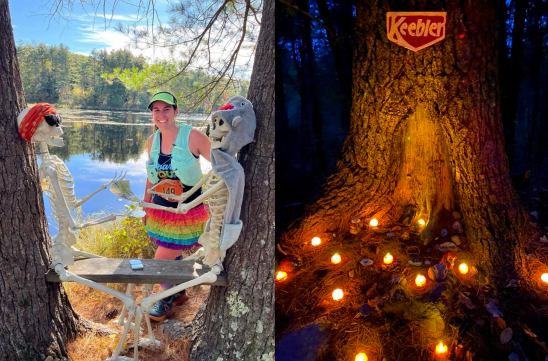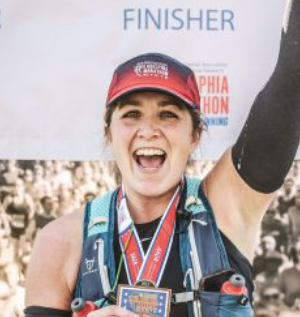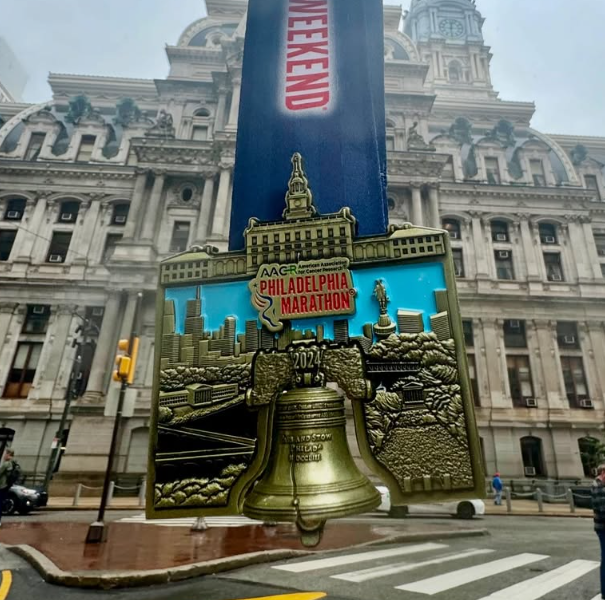
Race: Ghost Train Rail Trail Race: 30-Hour Ultramarathon
Runner: TRR Coach Allie Smith
Race Date: 10/18/2025
Location: Brookline, NH
Result: 45.017 miles in 16:56:19
3 Bests – What aspects of the race did you like the most?
- Festive: Halloween themed
- Timed race: I did the 30-hour version of the Ghost Train Rail Trail Race, removing any time cut-off pressure. Given the race directors knew how long runners would be on course, alongside the looped course, aid station snacks were refreshed throughout.
- Looped course: This allowed for the start/finish to be the central hub for all runners/volunteers/pacers/tents, and was easily accessible.
Not so much – Aspects of the race that didn’t do it for you
- Loop length: the 15-mile laps made it difficult to make any adjustments on-course.
- Night temperature: while fine for running, the low temperatures were chilly for camping overnight and anyone not running.
Weird factor – What’s the weirdest thing about this race?

There were a lot of Ghost Train Rail Trail Race runners dressed in Halloween costumes!
Highlights of your race – What did you do well and enjoy about your race in particular?
After struggling with GI issues and blisters after the second lap (miles 15 to 30), I wasn’t sure if I would be able to continue on for a third lap at night. I did a full reset and rested for a while before heading back out. This was my first time running into the night, and handled it with no caffeine and limited calories due to my stomach issues. Overall, I’m happy I did persevere! The result: setting a new distance PR during this race!
Lessons for others – Share your pro-tips on the race to help the next runner
A few tips for runners considering this race:
- October nights in New England can get VERY cold; therefore, it’s important to pack enough layers for running AND sleeping!
- Even in lower temperatures, hydration is still very important to stay on top of. Don’t be fooled by the lack of sweat!
- Talk to other runners. The looped course is conducive to chatting to other runners, and this makes the time go by very quickly.
Lessons you learned that will help you next time around
1. Stay on top of hydration.
2. Take care of feet early!
There’s no going back on these two things: once they start to go south, they’ll more than likely keeping going south.
Most important course specific knowledge to know about the race
1. The Ghost Train Rail Trail Race course is mostly hard-packed, rail-trail type terrain with a little bit of New England trail running mixed in.
2. The 4 mile aid station and 7 mile turnaround aid station are fully stocked with bathrooms.
Aesthetics – Is it a pretty course?
The race takes place in the fall, with some beautiful foliage and fun decorations throughout!
Difficulty – Is it a tough course?
No, it is a relatively flat and very well marked course.
Organized and well run – Did it feel like a well-oiled machine or were they flying by the seat of their pants?
Very well run! From the race director to each volunteer, everyone involved in the Ghost Train Rail Trail Race were amazing!

Competition – Is there a strong field?
Competition was not the main point of focus of Ghost Train Rail Trail Races, especially in the 30-hour event. The focus is more on completion.
Logistics – Does it require a special handshake, registration a year in advance, hotels all booked? Give us the low down on the nuts and bolts of making the race happen.
Registration was VERY competitive. For example, the 30-hour Ghost Train Rail Trail Race sold out in about 2 minutes! Fortunately, there are several different Ghost Train Rail Trail Race distance options.
Aid Stations – Standard fare or anything special to know about the aid stations in terms of what’s available or when?
Aid stations had plenty of snacks and sodas, with Tailwind as the endurance fuel option. The halfway aid station had a lot of homemade goodies and plenty of hot food!

Weather and typical race conditions
The Ghost Train Rail Trail Race happens during fall in New England, so can vary drastically. This year, it got quite cold during the night. Be prepared for everything, especially the worst!
Gear – Did you need anything special or is there anything you’d recommend for the next runner?
I definitely would recommend a good headlamp, as it can get super dark.
Spectators – Is this a friendly course for your friends?
Friends are able to hang out at the start/finish area, and pacers are allowed during the night portion.
How’s the Swag?
There is a wooden train ornament for finishers, as well as a PR star.
The Overall Score – How many stars do you give this race and do you recommend that others run it?
I would DEFINITELY recommend any of the Ghost Train Rail Trail Race events to others!!! It’s festive and fun, great weather (at least in 2025 there was!), a lot of aid station food and bathrooms, and very well run. Above all, it’s a great format to go for distance PR’s and to chat with other runners.

Allie Smith is a coach with Team RunRun based in Gloucester, MA. She enjoys helping the everyday athlete have fun, build confidence, and fall in love with running!





























